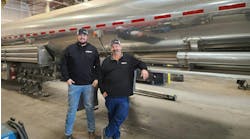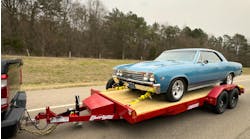To Borrow from the Mark Twain quote, predictions of a downturn in the transportation market are premature. Of course, no one in the business of building trucks and trailers has time to worry much about when this upcycle is going to turn. Investment analysts and economists, however, are paid to keep the crystal ball shiny, and to bet on the timing of the next bad thing—and the market will certainly turn. But not today. And probably not for a year of continued good times.
As this issue of Trailer/Body Builders goes to press, market forecasters ACT Research and FTR are both reporting record trailer orders for July.
ACT’s preliminary estimate for July 2018 net trailer orders is 29,300 units, while FTR’s slightly different math came in at a nonetheless “surprising” 28,000—also a record. Both numbers more than doubled the order totals from the July last year. And last year was not a bad year at all. Trailer orders have now totaled an impressive 350,000 units for the past twelve months.
Frank Maly, ACT’s Director of CV Transportation Analysis and Research, notes that “fleets came roaring back into the market” in July, with orders up 45% from the month before.
“Considering July is, historically, the industry’s weakest order month, this performance is truly exceptional. Year-to-date, net orders of just over 200k trailers are up 30% from 2017,” Maly said. “OEMs had their strongest July net order volume in history, breaking a record that was set in 1994.”
When seasonally adjusted, July came in as the second strongest monthly reading in industry history, Maly adds, converting to a “stunning” 528,000 annual rate. Both dry vans and reefers paced overall performance, closing the month with backlogs that now stretch into March of next year.
“While strength was evident across all industry segments, it is noteworthy that cancellations remain low, indicating strong fleet confidence as we move through the rest of this year and into next,” he notes.
Some of the surge can be attributed to OEMs having opened the 2019 order boards, so fleets have started ordering a couple months early to reserve build spots and lock in prices, according to ACT. Carriers expect to add more trucks in 2019 and will need additional trailers for them. Van orders were particularly strong, and dry van orders rebounded after a weak June.
Don Ake, FTR vice president of commercial vehicles, offers a similar take.
“This is a terrific order number for a month of July. Usually July is the lowest order month of the year, but not this year,” he says. “This indicates the trailer market should continue to be robust in 2019.”
Records are falling for new truck orders as well.
FTR reports that preliminary North American Class 8 orders for July hit an all-time high of 52,250 units, just surpassing the previous record of 52,194 orders in March 2006. Five of the highest 12 order months ever have occurred in the first seven months of this year, according to FTR, and North American Class 8 orders for the past twelve months have now totaled an “astounding” 445,000 units.
Remember how good 2005-2006 was? The economy was still at full speed, and the truck numbers were also juiced by a pre-buy ahead of 2007 emissions changes. Most of us thought, at the time, we’d never see such numbers again. Yet here we are.
Because fleets are frustrated by the current situation and are uncertain when they can receive trucks, they are placing a large volume of orders in hopes of getting some deliveries at some point in the future, FTR suggests. In essence, there is a truck shortage. OEM’s have been hindered because numerous parts and component suppliers have not been able to produce and deliver on time.
“The supply chain issues began around March. OEM’s started falling behind in deliveries to fleets in April. Deliveries did improve a bit in June, but most OEM’s are still operating in catch-up mode,” FTR’s Ake says. “It is uncertain when suppliers will be able to improve delivery times and for OEMs’ to ship all orders on time. Realistically it may take up to a year for everyone to catch up.”
Adds Kenny Vieth, FTR president and senior analyst, “Much of the past two-month order surge is attributable to dealers booking build slots for 2019 and not to say that current order activity will not be converted into customer sales, it is worth noting that as lead times extend, orders are inherently more speculative.”
The irony is that the trucking business is so good, there aren’t enough trucks available to deliver trucks—a problem plaguing upfitters and dealers everywhere. Spartan Motors, in its recent Q2 earnings report, said it has been dispatching its own drivers to retrieve chassis it had ordered.
What to do? Feature stories this month discuss how some trailer manufacturers and truck body builders are coping with supply chain problems, soaring costs, and pricing. And we’ll soon hit the road for forecast conferences from by ACT and FTR.
Where’s the market headed? Watch this space.










